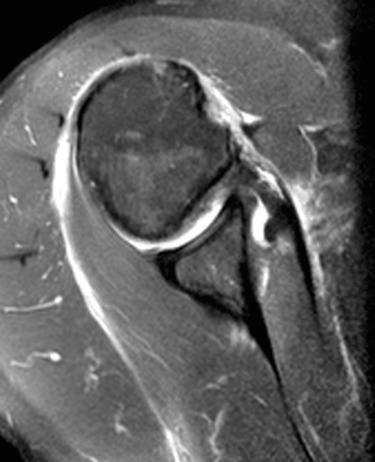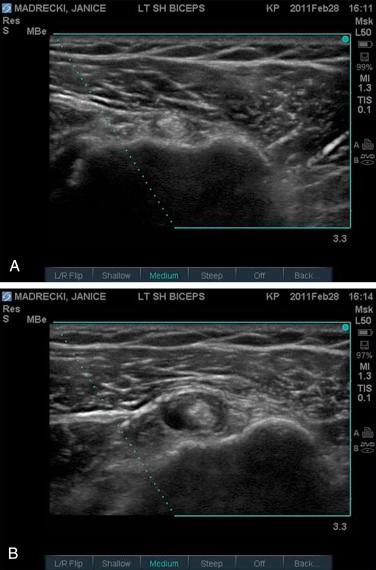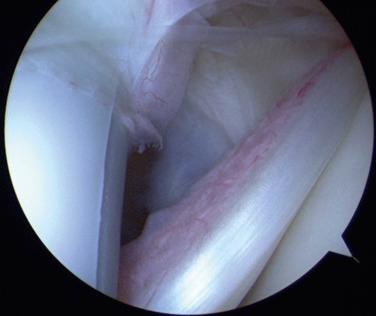Physical Address
304 North Cardinal St.
Dorchester Center, MA 02124
Pathology of the long head of the biceps tendon (LHBT), in particular biceps tendonitis, is a common cause of anterior shoulder pain among overhead athletes and manual laborers. Diagnosis relies on history and physical examination, supplemented with magnetic resonance imaging (MRI) in questionable cases. Nonoperative treatment with supervised physiotherapy, nonsteroidal antiinflammatories, and corticosteroid injections is successful in most cases. In refractory cases, open subpectoral biceps tenodesis (OBT) has excellent outcomes and infrequent complications. This procedure is a crucial element of the surgical armamentarium of the sports and shoulder surgeon.
Open subpectoral biceps tenodesis can be performed after arthroscopic tenotomy and any other arthroscopic procedures such as rotator cuff repair. Using a cosmetic axillary incision and an approach between the pectoralis and short head of the biceps, the anterior humerus can be exposed and the tenotomized long head retrieved and prepared with looped running nonabsorbable suture. An anterior humeral tunnel can then be drilled and the tendon tensioned, dunked into the tunnel, and fixated with an interference screw to rapidly and safely restore the anatomic length-tension of the long head of the biceps muscle while removing the entirety of the inflammed proximal tendon.
Biceps tendonitis frequently presents with concomitant pathology such as rotator cuff tears, acromioclavicular degenerative joint disease, glenohumeral osteoarthritis, and superior labrum anterior-posterior (SLAP) tears, which can make determining the importance of the LHBT in the patient’s symptomatology challenging.
Classically, patients with biceps tendonitis complain of anterior shoulder pain radiating distally into the belly of the biceps, worsened by overhead activities and athletic activities. Manual laborers may complain of pain exacerbated by repetitive flexion and supination, such as using a screw driver with the hand at shoulder level or above.
Mechanical symptoms such as popping or catching can occur, especially in association with bicipital instability, but are not common.
Most frequently patients give a history of repetitive microtrauma, although acute traumatic mechanisms can also occur.
Occasionally, spontaneous rupture will occur. In this case patients will provide a history of unremitting anterior shoulder pain following by an acute snap, ecchymosis, and a popeye deformity. This is usually accompanied by subsequent pain relief.
In patients with suspected bicipital tendonitis examination should begin with a comprehensive shoulder examination, including inspection, palpation, range of motion, strength testing including the rotator cuff, distal neurovascular examination, and finally specific provocative maneuvers.
One of the most commonly used physical examination maneuvers for bicipital tendonitis is tenderness to palpation at the bicipital groove, which lies 6–8 cm distal to the anterolateral corner of the acromion, with the shoulder in internal rotation. Tenderness that moves medially with internal rotation and laterally with external rotation is highly suggestive. The senior authors have found this test to be more clinically useful than Speed or Yergason tests.
Speed test for bicipital tendonitis is a reproduction of the patient’s symptoms with resisted elbow flexion.
Yergason test for bicipital tendonitis is a reproduction of the patient’s pain with resisted forearm supination.
A wide variety of clinical tests have been suggested for the pathology commonly associated with bicipital tendonitis. For instance, for SLAP tears possible tests include the active compression test, passive compression test, anterior slide test, crank test, Mayo dynamic shear test, and SLAPrehension test. For subscapularis tears, which are commonly associated with bicipital instability, the lift-off test, belly-press test, and internal rotation lag signs have all been described.
In overhead throwers an accurate measurement of bilateral shoulder rotational range of motion must be obtained with the patient supine and the scapula stabilized, as pathology of the biceps tendon and biceps anchor is commonly associated with glenohumeral internal rotation deficits (GIRD).
All patients with suspected bicipital tendonitis should first be evaluated with a complete set of shoulder radiographs including an anteroposterior view, a scapular-Y lateral view, and an axillary lateral view. These radiographs are obtained primarily to rule out concomitant pathology. The intertubercular groove itself can be visualized in profile by placing the cassette on top of the externally rotated shoulder with the beam directed distally, although obtaining this radiograph is technician-dependent, which limits universal use.
MRI is usually necessary to visualize the LHBT and superior labrum. Bicipital tendonitis may be associated with ovalization in the tendon, increased T2 signal intensity within the tendon, or fluid within the bicipital sheath. Fluid within the sheath may a normal finding with an arthrogram and thus the evaluating physician must know whether intraarticular contrast was utilized. A SLAP tear can be seen as a separation between the superior labrum and the superior glenoid, although considerable normal anatomic variation exists in this area leading to a high rate of false positives and a low positive predictive value. Subscapularis tears, longitudinal split tears in the biceps tendon, and dislocation of the biceps tendon from the intertubercular groove can also occur ( Figs, 49.1 , 49.2 ).

The sensitivity of magnetic resonance arthrography for tendinopathy of the LHBT has been reported to be 64%–93%, and the specificity has been reported to be 81%–96%.
The portion of the bicipital tendon within the intertubercular groove can be visualized on ultrasound, which may play a role in the future in the diagnosis of bicipital tendonitis. However, this modality does not allow for the assessment of intraarticular pathology such as SLAP tears, and thus it provides an incomplete picture of the proximal LHBT.
Asymptomatic MRI pathology of the superior labrum and LHBT is increasingly common in individuals of advancing age and thus in all cases MRI findings must be correlated with symptomatology and physical examination to establish the diagnosis.
Arthroscopy is the gold standard for diagnosis.
Nonoperative treatment usually consists of a combination of supervised physiotherapy, a home exercise program, ice or other superficial cryotherapy, nonsteroidal antiinflammatory medications, and avoidance of provocative activities with rest from sport and alteration of work duties. Therapy should focus on strengthening of the periscapular musculature and rotator cuff, as subtle malpositioning of the scapular or laxity within the glenohumeral joint may exacerbate biceps tendonitis. Baseball players should focus on stretching the posterior capsule to counteract GIRD, which may increase SLAP tears symptomaticity.
Injection of a local anesthestic and corticosteroid into the bicipital sheath can be both a diagnostic and therapeutic maneuver. Traditionally this injection was performed using palpable landmarks, but recently many surgeons are using ultrasound guidance, which significantly improves accuracy from 26.7% to 86.7% (see Fig. 49.2 ).

In those patients that fail nonoperative management, no consensus as to the best operative management exists. The two primary surgical options for biceps tendonitis are biceps tenotomy and biceps tenodesis. Biceps tenotomy is faster, less expensive, and potentially avoids complications associated with the axillary incision such as infection and complications associated with the humeral drill hole for the tenodesis such as fractures. Biceps tenodesis restores the anatomic length-tension relationship and thus avoids the “Popeye” cosmetic deformity and cramping with repetitive elbow flexion and/or forearm supination. No comparative studies have been able to demonstrate any difference in patient-oriented outcomes between these two interventions.
For patients with SLAP tears, SLAP repair is another surgical alternative to biceps tenodesis. The advantage of this technique is that it restores the patient’s anatomy and has thus traditionally been thought to have the highest likelihood of restoring native glenohumeral kinematics. However, in patients with bicipital tendonitis, this procedure leaves the inflammed portion of the biceps tendon intact, and thus the patient can have residual anterior shoulder pain. Return to play after this procedure is unpredictable and has been demonstrated to be inferior to biceps tenodesis in a prospective comparative study.
The LHBT has a unique anatomic course. Distally, the long head of the biceps muscle lies lateral to the short head of the biceps, which runs with the coracobrachialis to the conjoint tendon and coracoid process proximally. At this level, the musculocutaneous nerve lies variably within the short head of the biceps or coracobrachialis, and the neurovascular bundle lies just medial and posterior to the short head. The musculotendinous junction of the long head lies at the level of the inferior edge of the pectoralis major on the anterior humerus. The LHBT then courses proximally through the intertubercular groove just lateral to the lesser tuberosity and subscapularis tendon under the transverse humeral ligament, which serves as a continuation of the subscapularis.
At the proximal subscapularis, the LHBT turns 30 degrees medially and posteriorly, suspended by a pulley made up of the the coracohumeral ligament, superior glenohumeral ligament, supraspinatus, and subscapularis. The tendon then travels through the rotator interval to attach on the supraglenoid tubercle and/or superior labrum. Although the tendon is intraarticular, it is extrasynovial.
Pathology of the LHBT can occur at its attachment site as a SLAP tear, within the glenohumeral joint as bicipital tendonitis, visualized as the lipstick lesion ( Fig. 49.3 ), or within the intertubercular groove in a portion of the bicipital tendon that cannot be visualized intraarticularly. Throughout its course, the LHBT is extensively innervated and possibly is a primary pain generator in the shoulder.

Tenodesis has been proposed in several locations along the anatomic course of the biceps. Listed in order from most biceps tendon remaining to least biceps tendon remaining, these include arthroscopic soft tissue tenodesis at the level of the pulley, arthroscopic osseous tenodesis above the pectoralis tendon, arthroscopic osseous tenodesis within the groove, and open subpectoral tenodesis beneath the pectoralis. Some surgeons have suggested that proximal tenodesis may leave an inflamed, pathologic, pain-generating tendon within the intertubercular groove, and may thus increase the likelihood of residual pain and the need for future surgery. Open subpectoral biceps tenodesis avoids these potential issues as the tenodesis is performed at the most distal possible location.
The primary indication for biceps tenodesis is bicipital tendonitis that has failed a full course of nonoperative treatment and continues to have debilitating symptoms. Because this pathology often responds to nonoperative measures, a full trial of nonoperative treatment should be attempted.
Other indications include tears of the biceps tendon greater than 25%–50%, biceps tendon instability, failed SLAP repairs, and symptomatic type 2 and 4 SLAP tears in older patients.
Many authors recommend biceps tenodesis as a prophylactic measure with repair of all large rotator cuff tears.
In rare circumstances, biceps tenotomy may result in unacceptable cramping, weakness, or cosmetic deformity, and can indicate a patient for revision with a tenodesis.
Contraindications include active infection, complex regional pain syndrome, musculocutaneous nerve palsy, and pseudoparalysis of the shoulder.
Open subpectoral biceps tenodesis can be performed with subtle alterations to both the lateral decubitus and beach chair positions. Regardless of the surgeon’s preference for positioning and regardless of the concomitant procedures planned, open subpectoral biceps tenodesis can easily be appended at the completion of the procedure if the surgeon can be flexible intraoperatively. A standard shoulder arthroscopy should first be performed in the position of the surgeon’s preference. During this procedure tenotomy of the biceps tendon at the superior labrum is performed. This portion of the procedure will not be covered in this chapter as it is covered elsewhere within the text. The other planned procedures are also performed. Once these procedures are complete, the arthroscope is withdrawn from the shoulder and attention is paid to the axilla for the tenodesis.
From the standard lateral decubitus position, the surgeon should first remove the arm from both abduction and axial traction. The beanbag can then be deflated and the patient can be rolled toward the supine position into a “sloppy lateral” position to allow the surgeon easy access to the anterior shoulder. The arm can then be placed on a padded Mayo stand.
From the standard beach chair position, the patient is reclined an additional 20–30 degrees. If an articulated device was used during the arthroscopy to position the arm, it can be removed at this time and the arm can be placed on a padded mayo stand to allow the surgeon to gain easier access to the axilla for the tenodesis.
If biceps tenodesis is the sole procedure planned, generally the beach chair position offers easier access to the axilla.
While standard shoulder draping can be used, because the incision for biceps tenodesis lies near and within the axilla, a primary location of Propionibacterium acnes, we prefer to supplement with an occlusive, adherent, iodinated drape (Ioban ©, 3M Inc., St. Paul, MN).
We usually perform this procedure under both general and regional anesthesia, with an ultrasound-guided interscalene, or supraclavicular blockade. Other surgeons may prefer to utilize regional anesthesia coupled with sedation. Although a shoulder arthroscopy may be performed under an ultrasound-guided suprascapular nerve block, this block generally does not cover the area of an open subpectoral biceps tenodesis.
The surgeon should learn to perform open subpectoral biceps tenodesis in both the beach chair and lateral decubitus positions so that this can be performed as an adjunct to a variety of other shoulder procedures without dictating positioning.
Whether the lateral decubitus or beach chair position is used, removing the arm from traction and the articulated positioner is crucial, to allow sufficient access to the axilla and manipulation of the arm during the tenodesis.
Whether the lateral decubitus or beach chair position is used, subtly repositioning the patient between the arthroscopy and the tenodesis can make the tenodesis markedly easier.
Rigidity on the part of the surgeon—for instance, only performing tenodesis in the beach chair position—limits the surgeon’s options and may prevent the surgeon from achieving the optimal outcome.
Failure to remove the arm from traction or the arm holder can make open subpectoral tenodesis very difficult.
Failure to reposition the patient between the arthroscopy and the tenodesis can make the tenodesis more difficult to perform and thus can increase the likelihood of complications and decrease surgical efficiency.
Become a Clinical Tree membership for Full access and enjoy Unlimited articles
If you are a member. Log in here